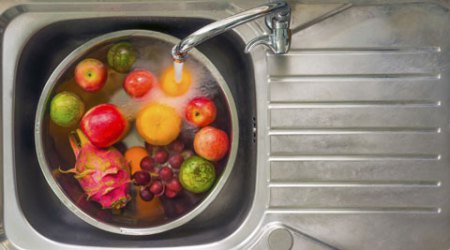
A recent study has indicated that on average, Americans only consume about one serving of fruits and vegetables per day. That’s only 1/3 of the amount recommended consumption of fruits and vegetables by the USDA. While it seems that the issue surrounding fruits and vegetables is our amount consumed, many insist that the problem lies in the availability of pesticide-laden produce. Whole communities of consumers advocate for the consumption of organic produce to reduce their pesticide intake, but is this really necessary?
A pesticide is a substance that is used to kill, prevent, or control pests such as insects, rodents, molds, weeds, or plant diseases in crops. Pesticides are typically chemical or biological substances such as viruses, bacteria, or disinfectants and mainly afford plant disease control benefits that can improve crop yields and prevent diseases in humans. A primary concern of consumers is the amount of pesticide residues that could be left on produce and their potential affects along with the regulation and control of pesticide usage. In fact, the approval and regulation process of pesticides is quite extensive and primarily focuses on perfecting crop dosage and keeping pesticide residues on produce to the lowest amount possible.
The U.S. Environmental Protection Agency (EPA) is primarily responsible for all regulation of pesticides. All pesticides that are used in the U.S. must be registered with them and manufacturers must apply for registration of all new pesticides and must present information to the EPA such as the new substance’s chemical ingredients, risks to humans, details on the manufacturing process, and usage directions. The EPA reviews all scientific data on the pesticide, reviews its risks, sets a maximum legal residue tolerance, considers comments from the public, and either requests that the manufacturer makes changes to their product or approves it for use. All pesticides are reviewed periodically to ensure that they still meet criteria. The EPA is very interested in the potential risks that pesticide residues pose in food. For this reason, they use a worst-case scenario when setting limits. When limits of pesticide residue exposure is set, the EPA sets them to 100 times less than the actual scientifically determined limit to ensure limit thresholds are as small as possible and to ensure that if a person meets the limit of pesticide consumption, no significant harm would be done to them.
It is commonly understood that organic farming does not include the use of pesticides, but as explained here, organic farming does use pesticides, but mainly natural ones that break down more easily in the environment, whereas conventional farming uses synthetic pesticides, though some synthetic pesticides are also approved for organic farming as well. Here is yet another case where natural does not necessarily mean superior and here’s why:
-Natural pesticides are many times less effective and have the potential to be more harmful than synthetic pesticides. Since natural pesticides break down faster in the environment, farmers may have to spray their crops more frequently, resulting in higher amounts of pesticides applied to crops.
-Natural pesticides include using substances that plants produce themselves to protect from disease and pests. These natural pesticides may not be as closely regulated due to their natural presence in a crop.
-Natural pesticides do not have the same specificity as their synthetic counterparts and some may be more harmful to humans than synthetic pesticides that are engineered to affect biochemical pathways in plants that simply don’t exist in humans or any mammals as in the case of glyphosate.
Overall, our food supply is made safer by the use of pesticides whether natural or synthetic. Considering that most Americans are only consuming one serving of fruits and vegetables on average per day, the potential negligible amount of pesticide residues present is worth the risk for innumerable benefits that eating fruits and vegetables pose. Although, it never hurts to increase regulation and testing and to always wash fruits and vegetables before consuming them no matter if they are conventional or organic.
Sources
http://www.cdc.gov/nutrition/downloads/State-Indicator-Report-Fruits-Vegetables-2013.pdf
http://www.nap.edu/catalog/5150/carcinogens-and-anticarcinogens-in-the-human-diet-a-comparison-of













